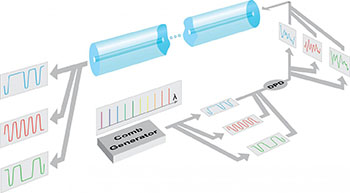
The UCSD workers used a frequency comb to pre-condition data carriers in the fiber into correlated daughter pulses. The correlation allowed the Kerr effect to be detected and subtracted out at the receiving end. [Image: UCSD Photonic Systems Group]
Scientists at the University of California, San Diego (UCSD), USA, have reportedly devised a method to use frequency combs to cancel out critical nonlinear distortions in long runs of fiber-optic-transmitted data—and, in principle, to pack significantly more data capacity into the existing fiber system (Science, doi: 10.1126/science.aab1781). The team believes that the approach could represent one possible solution to the looming fiber “capacity crunch,” identified as one of the “grand challenges” in the National Research Council’s landmark 2013 report on U.S. national priorities in optics and photonics.
Zeroing in on the Kerr effect
The capacity concerns for the current fiber system—the result of exponential increases in demand for Internet bandwidth—hinge largely on so-called Kerr nonlinearities. These distortions occur as the intensity of the optical signal increases (for example, to cover long distances in fiber runs): interactions between the light’s electric field and the electrons in the silica fiber effectively change the fiber’s refractive index, leading to a phase delay in the signal.
The upshot is that the signal becomes distorted across long fiber runs in a way that appears random or stochastic, and thus can’t easily be subtracted out. The current fiber system can generally handle these problems through the use of amplifiers and repeaters along the fiber run. But as Internet bandwidth demands continue to soar in an era of data centers, rich media, and the “Internet of Things,” fiber experts say that the system will run up against a fundamental limit of optical fiber capacity, the so-called nonlinear Shannon limit—of which the Kerr nonlinearities constitute an important component.
Frequency combs pre-condition the signal
The UCSD team turned to an increasingly prominent and versatile optical technology, frequency combs, to try to neutralize the Kerr effect. They pre-conditioned the data-carrying laser pulse by passing it through a frequency comb, to create a series of mutually coherent daughter carriers out of the single pulse. Because of the mutual coherence, the Kerr-effect-induced behavior of individual daughter pulses was correlated, and could be identified and subtracted out at the receiving end, when the signal was recombined. In effect, by splitting the initial pulse into correlated components, the workers changed an apparently stochastic process, Kerr nonlinearity, into a deterministic one.
The team was able to demonstrate the transfer and successful decoding of information through a lab setup that emulated a 1,020-km run of fiber, with standard amplification every 85 km and with no repeaters. The system suppressed nonlinear effects and maintained a high signal quality despite an order-of-magnitude increase in signal power in the course of the experiment.
“Redefining” the data economy?
Widespread rollout of the new system in the current fiber network would require the implementation of new chips for generating and processing optical signals. Still, by boosting the throughput of existing fiber, it could delay for a few more years the expensive proposition of laying new, higher-bandwidth fiber to replace the current system, and thereby offer one approach to staving off the fiber capacity crisis in the near term. Indeed, the authors of the paper assert that, by potentially taming the Kerr-effect beast and eliminating the need for repeaters in the fiber stream, their work could “completely redefine the economy on which the present data traffic rests.”
